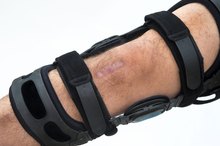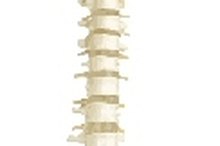Symptoms of Lumbar Hemangioma
A lumbar hemangioma is a benign blood vessel tumor that grows along one or more vertebra of the lower back. This type of tumor is most frequently diagnosed in patients between the ages of 30 and 50 and may not cause noticeable symptoms, according to Scoliosis and Spine Associates. Symptomatic patients should consult a physician to ensure receipt of an accurate diagnosis and appropriate treatment.
Lower Back Pain
The most common symptom associated with a lumbar hemangioma is lower back pain, Back.com reports. The severity of lower back pain depends on the size of the noncancerous tumor. A large tumor can distort the alignment of the vertebrae, leading to spinal cord compression and severe pain. Patients who experience severe or persistent lower back pain should seek care from a doctor.
- The most common symptom associated with a lumbar hemangioma is lower back pain, Back.com reports.
Decreased Sensation or Paralysis
What Are the Treatments for a Vertebral Hemangioma?
Learn More
A hemangioma that grows along the lower spine can injure or irritate nerves in the spinal column. Nerve irritation can interfere with the transmission of nerve signals throughout the body. If this occurs, patients with a lumbar hemangioma can experience sensations of tingling or numbness in their limbs, particularly the legs or feet. Cedars-Sinai Medical Center reports that severe nerve damage caused by a lumbar hemangioma can lead to leg paralysis, which is the inability to voluntarily control leg movements. Lumbar hemangiomas that cause these symptoms typically need to be removed by a surgeon.
- A hemangioma that grows along the lower spine can injure or irritate nerves in the spinal column.
Urinary or Fecal Incontinence
Nerves in the spinal column are responsible for controlling a person's ability to voluntarily urinate or defecate. A lumbar hemangioma that damages these nerves can cause urinary or fecal incontinence symptoms in affected patients, Scoliosis and Spine Associates explains. Urinary or fecal incontinence is characterized by a patient's inability to voluntarily control urine or stool elimination, respectively.
Related Articles
References
- Back: Tumors: Benign - Hemangioma
- Indiana University-Purdue University: Hemangioma of Bone
- Cedars-Sinai Medical Center: Hemangioma
- BoneTumor: Hemangioma
- Putzer M, Ehrlich I, Rasmussen J, Gebbeken N, Dendorfer S. Sensitivity of lumbar spine loading to anatomical parameters. J Biomech. 2016;49(6):953-958.
Writer Bio
Rae Uddin has worked as a freelance writer and editor since 2004. She specializes in scientific journalism and medical and technical writing. Her work has appeared in various online publications. Uddin earned her Master of Science in integrated biomedical sciences with an emphasis in molecular and cellular biochemistry from the University of Kentucky College of Medicine.









